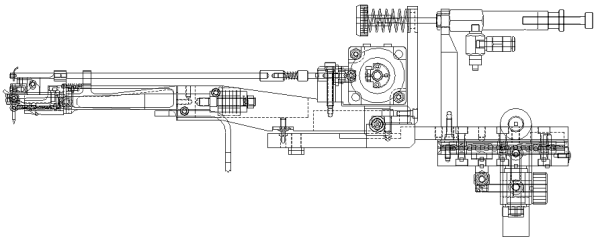|

1551 S. Harris Court, Anaheim, CA 92806 Anaheim, CA 92806
Phone: 714.978.1551  Fax: 714.978.0431 Fax: 714.978.0431
Specifications: Model 7700D Series, Ball-Wedge Wire Bonders, Manual X-Y-Z Last Revised: 4/18/2003
Overview
Year 2000 saw the "C" Series finally replace the venerable "A" Series, and now witnesses the transition from "C" to "D". The "C" Series brought forth improvements to the core X-Y-Z manipulator – independently guided and locked axes – but retained the "A" Series tool assembly. Now "D" Series brings across the revolutionary "E" wire clamps and groups them with their drive motor and a full wavelength transducer on a new tool assembly pivoted as before. The X-Y-Z follower mechanism has improved linear ways and accepts the new tool assemblies of the wire bonders as well as other cast-body tool assemblies.
The ball-wedge wire bond configuration is shown below.

Application
Machines of this series bond gold wires ranging from 0.0007 in. to 0.002 in. Bonds are made by the ball-to-wedge technique using ultrasonic energy and work piece heat. Wire is clamped and threaded vertically through a hollow capillary, allowing independent feeding action. The connection is begun with a ball formed on the end of the wire stock by electric discharge, and completed by a wedge bond under the end of the capillary tool. The operator using hand/eye reference to bond targets and elevations guides the bonding tool manually.
Bond Tool Head Assembly
The all-new tool assembly of this series features wire clamps brought over from "E" Series. The clamps are air-opened and spring-closed, and have a self-contained closure pivot. A separate pivot generates the clamp feed motion. Alignment of clamps to the tool is facilitated by individual adjustments along three axes. Actuation of all clamp motion is by the same spiral cam of an onboard motor. Appropriate clamp motion settings are configured in software and are retained in non-volatile memory.
The ultrasonic transducer is K~Sine Model K~77D-C, 1˝ wavelength, operating at a nominal frequency of 63 Khz and with capillary length of 0.625-in. extended 0.531-in. below center. Ultrasonic power supply is K~Sine built-in, five Watts, dual channel.
Two values of bond force in the overall range of 18 to 90 grams are adjusted at the tool assembly as two preset positions of a compression spring. Either high or low force setting can be programmed for each bond. Initiation of bonding is upon the opening of the firing switch. The elevation at which to feed wire and to stroke the torch wand for ball formation is measured from each bond by an optical encoder on the Z Axis.
Mechanical
Throat reach is 5.125-in. from tool home position back to the machine lower panel. Vertical clearance above the work plane is approximately 0.250-in. over the throat reach distance. The pivot radius of the tool assembly is the same 8.688-in. extant for West·Bond’s history, as is the pivot radius of 12.000-in. of the X-Y-Z manipulator assembly. Range of movement of the tool by manipulator control is 0.563-in. vertically and 0.625-in. in horizontal directions with an 8/1 ratio of mechanical advantage.
The work platform is a bolt-on assembly. An optional adjustable height platform is available as Feature -79 .
ESD Protection
Protection against Electrostatic Discharge is implemented by finishing exposed tool assemblies and other moving parts by Electroless Nickel plating, which is conductive; and all exposed painted parts with a powder-coated paint that is dissipative.
Electrical Software and Hardware
Control of machine logic, motor motions, and Ultrasonic energy is programmed to and executed by West·Bond Part No 8100 CPU containing a Motorola 68000 microprocessor and 256 KB of nonvolatile RAM. All machine configuration constants and bond settings are programmable at the machine panel, prompted by a series of "screens" displayed on a 4-line 40-character LCD. Three separate buffers of bond settings for a wire type can be entered and selected during bonding by a selector switch. Each wire type can have one, two, or three stitch bonds; each with its own settings of ultrasonic power, and time. All programmed values are displayed during bonding. At "home", various options are enabled.
To form precisely sized balls, the motor-controlled spiral cam drives the clamps to feed an exact new length, and a controlled quantity of electrical energy is discharged to the free wire end.
Definitions of Models of this Series:
- Model No. 7700D. This machine described herein.
Features available for this Series:
- Feature No. 79. Adjustable height work platform.
Machine Configuration
The microscope recommended for this series is Nikon SMZ660 with the "Luxuray" LED No. 10265.01 illuminator. Neither microscope nor illuminator are included. One recommended bonding tool is included.
All work holders are priced separately. Quite a large number of previously designed special work holders, both heated and unheated, are listed under Products, Workholder Assemblies, on West·Bond’s Web Site. Those with Status of "Current" are maintained in stock and can be ordered with machines: This selection covers most needs. If a selection must be made with Status "AvailableNotStocked", then it must be ordered on a separate purchase order.
Services Required
Compressed air, regulated to 50 psig, is required. Connection is via 1/4-inch tubing.
Electrical service required is 100-120 VAC, 50-60 Hz, 2 Amps. For 200-240 VAC, an external step-down transformer is required which must be secured by end-user as electrical codes vary from country to country.
Dimensions
Machine size is 22" deep X 19" wide X 12" high, exclusive of microscope, or 18" in height to scope eyepieces. Weight is 60 lb. uncrated, or 95 lb. crated.
Click here to see Photos of Bond Tool Assembly.

1551 S. Harris Court, Anaheim, CA 92806 Anaheim, CA 92806
Phone: 714.978.1551  Fax: 714.978.0431 Fax: 714.978.0431
Products | News | Events
| Support | Corporate | Contact Us | Universities | Home
Manual Die Bonders | Manual Wire Bonders | Semi-Automatic Wire Bonders | Automatic Wire Bonders | Pull Test Machines
|